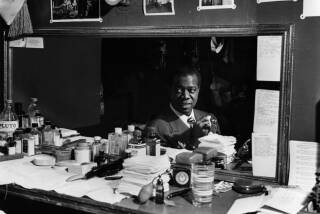How the team behind ‘Bill & Ted Face the Music’ assembled a band that could save the universe
- Share via
Ever since the 1989 cult comedy “Bill & Ted’s Excellent Adventure” sent them traveling through time in a cosmic phone booth, slacker friends Ted “Theodore” Logan (Keanu Reeves) and Bill S. Preston Esq. (Alex Winter) have explored some profound historical and philosophical questions.
For example, what would Genghis Khan do if you set him loose in a suburban sporting goods store? If Billy the Kid, Socrates, Napoleon and Sigmund Freud were all hanging out, what would they talk about? And who would win if you played the Grim Reaper in a game of Twister?
Now, nearly 30 years after their last outing, 1991’s “Bill & Ted’s Bogus Journey,” the dim-witted duo are back in an unlikely third installment in the series, “Bill & Ted Face the Music,” which hits theaters and premium VOD Friday. And this time, there’s a new and most excellent brain-tickler to ponder: If you were recruiting a supergroup of the greatest musicians from throughout history to help create a song that could save the universe, who would you choose?
In “Face the Music,” the heavy-metal-loving but musically inept Bill and Ted, now deep into the doldrums of middle age, are given the impossible task of creating the greatest song ever written in order to prevent the fabric of space and time from being ripped apart. (Just go with it.)
With no idea where to even start, the two begin a frantic dash through time in search of desperately needed musical inspiration. Along the way, they get critical help from their teenage daughters, Billie (Brigette Lundy-Paine) and Thea (Samara Weaving), who assemble a group of legendary musicians from the past, including Louis Armstrong, Jimi Hendrix and Wolfgang Amadeus Mozart.
The 10-plus-year effort to get “Face the Music” to the screen has been, in its own way, as twisty and improbable as Bill and Ted’s onscreen journeys. From the outset, returning screenwriters Ed Solomon and Chris Matheson knew that the story of the third film, like the previous two, would be centered on music. But over the course of the project’s development, as the creative team struggled to nail down financing, the script went through numerous wildly different iterations.
“Originally there wasn’t a supergroup — it was just Bill and Ted’s kids,” says Solomon, whose other credits include “Men in Black” and “Now You See Me.” “It was further down the road that we had this idea that the daughters, trying to help their dads, would put together this band. After that it was just throwing out names: What about this person? What about that person? We were looking for characters that were iconic but also embodied different styles of music and that when put together would be odd and interesting and hopefully work together.”
After kicking around possibilities like ragtime composer Scott Joplin and blues great Robert Johnson, Solomon and Matheson, along with director Dean Parisot (“Galaxy Quest”) and music supervisor Jonathan Leahy, zeroed in on pioneering jazz trumpeter Armstrong, rock legend Hendrix and Mozart.
“The conversation revolved around how recognizable we wanted the historical musicians to be,” says Leahy. “If you fill the movie full of extremely esoteric musicians, as brilliant as they might be, at some point are you losing the audience and not having as much fun? So we decided to stick with really well-known household names and just have fun with that.”
Though comic works like the “Bill & Ted” films are generally allowed some liberties when it comes to the use of historical figures, the filmmakers faced certain restrictions when it came to Armstrong and Hendrix. While the two musicians — who are played in the film, respectively, by actors Jeremiah Craft and DazMann Still — could be depicted as characters onscreen, their estates forbade their likenesses from being used in any advertising for the film, including on its poster.
More importantly, given the prohibitive cost to secure the rights, none of Armstrong or Hendrix’s actual music could be used in the movie. Instead, the two are shown playing snippets of “When the Saints Go Marching In” and “Amazing Grace,” both songs that are in the public domain. “We had to create things that were rights-free because we had a budget of just slightly above zero for the whole thing,” Parisot says dryly. (Orion Pictures declined to confirm the budget but reports have pegged the film’s production cost at $25 million.)
To provide the actual music played onscreen by these revered musicians, Leahy brought in Grammy-nominated jazz trumpeter Christian Scott and multi-instrumentalist Ray Suen, who supplied both Hendrix’s guitar and Mozart’s keyboard playing. “As someone who grew up playing the trumpet and then became a guitar player, when I read Louis Armstrong and Jimi Hendrix in a script, it jumps out at me, like we have to get this right,” Leahy says. “We said, ‘We’re not trying to copy Louis Armstrong and Jimi Hendrix. We want to play with the same passion and spirit and fire but it’s not at all an impersonation.’”
To help round out the historical supergroup, Solomon and Matheson landed on the idea of incorporating Ling Lun, who, according to ancient lore, is said to be the founder of Chinese music and is credited by texts dating back to circa 200 BC with pioneering the use of the bamboo flute. While Ling Lun has historically been referred to as a man, the “Face the Music” team decided to make the character female. (She is played in the film by Sharon Gee.)
“We wanted to diversify things, and to the degree that we could escape that part of the movie being too male-centric we wanted to do that,” says Matheson, who has also collaborated with Solomon on the films “Mom and Dad Save the World” and “Imagine That.” “There were conversations: ‘Can we do this? Can we make Ling Lun a woman?’ And in the end we just decided to do it. Ling Lun is possibly a mythic character so, well, who knows, right?”
To be fair, the “Bill & Ted” franchise has never exactly been huge on historical accuracy. (To cite just one example, when Bill and Ted time-travel to 15th century England in the first film, they are ordered by some “royal ugly dudes” to be placed in an iron maiden, a torture device not invented until some 300 years later.) “Sometimes we’ll hit a roadblock and we’ll look at each other and go, ‘Who else existed in the past that we can think of?’” says Matheson. “It’s so sad and embarrassing to admit.”
With the character of Death (played by William Sadler) brought back from “Bogus Journey” to serve as the supergroup’s bass player, that left only a drummer. Rather than go with some late icon of the drumming world like, say, the Who’s Keith Moon or Led Zeppelin’s John Bonham, Matheson and Solomon decided to create a wholly fictional character, a prehistoric woman named Grom who, according to the film, is the greatest drummer who ever lived and is played in the film by real-life drummer Patty Anne Miller, who has backed artists like Beyoncé and CeeLo Green.
“Grom didn’t exist but rhythm has been around forever,” says Parisot. “So to bring in Paleolithic rhythm seemed like a cool thing to do.” (“We did no research on that one,” Matheson admits, deadpan.)
Further boosting the film’s musical cred, Foo Fighters frontman Dave Grohl came in to do a cameo, as did rapper and producer Kid Cudi, who plays a more expansive role as a quantum-physics-obsessed version of himself. “We heard that Kid Cudi was a huge ‘Bill & Ted’ fan so we asked him if he’d be interested in playing this role,” says Solomon. “We gave him the script and 90 minutes later he said, ‘I’m in.’ ”
Arriving nearly three decades after the last installment — in the middle of a pandemic, no less — it remains to be seen whether “Face the Music” will harmonize with today’s audiences. But for Matheson and Solomon, the fact that the film exists at all is already a kind of victory.
“We didn’t expect that Bill and Ted would last culturally,” says Solomon. “I mean, the first movie got trashed. Your paper beat the crap out of us! We did not expect this thing would weirdly grow over three decades. It’s like an investment that someone made for you 30 years ago that you forgot about and suddenly it’s grown into something beautiful. It’s kind of a miracle that it’s here.”
More to Read
Only good movies
Get the Indie Focus newsletter, Mark Olsen's weekly guide to the world of cinema.
You may occasionally receive promotional content from the Los Angeles Times.











